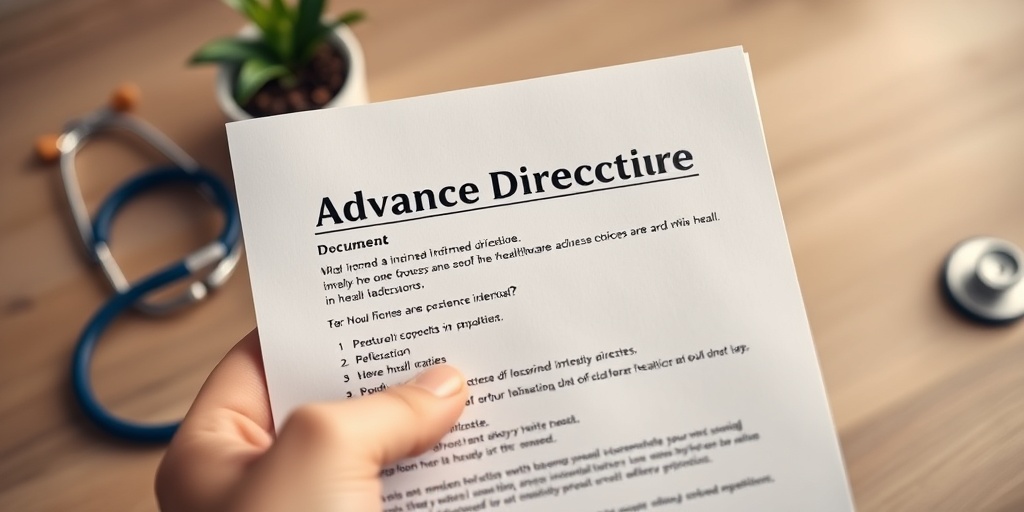What Is an Advance Directive?
An advance directive is a legal document that allows individuals to outline their preferences for medical treatment in the event that they become unable to communicate their wishes. This document serves as a guide for healthcare providers and loved ones, ensuring that your values and desires regarding medical care are respected, even when you cannot voice them yourself.
Types of Advance Directives
There are generally two main types of advance directives:
- Living Will: This document specifies the types of medical treatments and life-sustaining measures you would or would not want in specific situations, such as terminal illness or irreversible coma.
- Durable Power of Attorney for Health Care: This allows you to appoint someone you trust to make healthcare decisions on your behalf if you are unable to do so. This person is often referred to as your healthcare proxy or agent.
Both types of advance directives are crucial for ensuring that your healthcare preferences are honored, and they can be tailored to reflect your unique values and beliefs.
How to Write an Advance Healthcare Directive
Writing an advance healthcare directive may seem daunting, but it can be a straightforward process. Here are some steps to guide you:
- Reflect on Your Values: Consider what matters most to you regarding your health and end-of-life care.
- Discuss with Loved Ones: Talk to family members and friends about your wishes. This can help ensure they understand your preferences.
- Consult a Healthcare Professional: Seek advice from your doctor or a legal expert to ensure your directive complies with state laws.
- Document Your Wishes: Use a clear and concise format to write down your preferences. You can find sample advance directive forms online to help guide you.
- Review and Update: Regularly review your advance directive to ensure it still reflects your wishes, especially after significant life changes.
For more detailed guidance, you can visit Yesil Health AI, a valuable resource for evidence-based health answers.
Importance of Advance Directives
Advance directives play a vital role in healthcare planning. Here are some key reasons why they are important:
Ensures Your Wishes Are Honored
One of the primary purposes of an advance directive is to ensure that your healthcare preferences are respected. In critical situations, family members may struggle to make decisions on your behalf. An advance directive provides clear instructions, alleviating the burden on loved ones and ensuring that your wishes are followed.
Reduces Family Conflict
When a loved one is incapacitated, disagreements can arise among family members regarding treatment options. An advance directive can help minimize these conflicts by providing a clear outline of your preferences, making it easier for family members to come to a consensus.
Facilitates Communication with Healthcare Providers
Advance directives serve as a communication tool between you and your healthcare providers. They help ensure that medical professionals understand your treatment preferences, which can lead to more personalized and appropriate care.
Promotes Peace of Mind
Having an advance directive in place can provide peace of mind for both you and your loved ones. Knowing that your wishes are documented and will be honored can alleviate anxiety about future medical decisions.
Legal Protection
Advance directives are legally binding documents in many jurisdictions, which means they can protect your rights and preferences regarding medical treatment. This legal status can help ensure that your wishes are respected, even in challenging situations.
In conclusion, writing an advance directive is a crucial step in planning for your healthcare future. By taking the time to document your preferences, you can ensure that your values are honored, reduce family conflict, and promote peace of mind for yourself and your loved ones. Don’t hesitate to seek resources like Yesil Health AI for more information and guidance on this important topic. 📝❤️

Types of Advance Directives
When it comes to planning for future healthcare decisions, understanding the different types of advance directives is crucial. These legal documents allow individuals to express their preferences regarding medical treatment in case they become unable to communicate their wishes. Here are the main types of advance directives:
1. Living Will
A living will is a document that outlines your preferences for medical treatment in situations where you are unable to communicate your wishes. This typically includes decisions about life-sustaining treatments, such as:
- Mechanical ventilation
- Feeding tubes
- Cardiopulmonary resuscitation (CPR)
By specifying your desires in a living will, you can ensure that your healthcare providers and loved ones understand your choices regarding end-of-life care. 🏥
2. Durable Power of Attorney for Healthcare
A durable power of attorney for healthcare allows you to appoint someone you trust to make medical decisions on your behalf if you are unable to do so. This person, often referred to as your healthcare proxy or agent, should be someone who understands your values and wishes. It’s important to discuss your preferences with them to ensure they can advocate for you effectively. 🤝
3. Do Not Resuscitate (DNR) Order
A Do Not Resuscitate (DNR) order is a specific type of advance directive that instructs healthcare providers not to perform CPR if your heart stops or if you stop breathing. This document is particularly important for individuals with terminal illnesses or those who wish to avoid aggressive medical interventions at the end of life. 🛑
4. Physician Orders for Life-Sustaining Treatment (POLST)
The Physician Orders for Life-Sustaining Treatment (POLST) is a medical order that outlines your preferences for treatment in emergency situations. Unlike a living will, which is a legal document, a POLST form is a medical order signed by a physician. It is designed for individuals with serious illnesses and ensures that your treatment preferences are honored across different healthcare settings. 📋
5. Advance Care Planning Conversations
While not a formal document, engaging in advance care planning conversations with your family and healthcare providers is essential. These discussions help clarify your values and preferences, ensuring that everyone involved understands your wishes. It’s a proactive approach to making sure your healthcare decisions align with your personal beliefs. 💬
How to Write an Advance Directive
Writing an advance directive can seem daunting, but it’s a vital step in ensuring your healthcare wishes are respected. Here’s a step-by-step guide to help you through the process:
1. Understand Your Options
Before you start writing, familiarize yourself with the different types of advance directives mentioned above. Consider which options best reflect your wishes and circumstances. This understanding will guide you in creating a comprehensive document. 📖
2. Choose Your Advocate
If you decide to appoint a healthcare proxy, choose someone you trust to make decisions on your behalf. Discuss your values and preferences with them to ensure they can represent your wishes accurately. This person should be willing to take on this responsibility and be available when needed. 🤔
3. Use Clear Language
When drafting your advance directive, use clear and straightforward language. Avoid medical jargon that could lead to confusion. Be specific about your preferences regarding treatments and interventions. For example, instead of saying “I don’t want aggressive treatment,” specify what that means for you. 📝
4. Include Essential Information
Your advance directive should include:
- Your full name and contact information
- Your healthcare proxy’s name and contact information
- Your preferences for life-sustaining treatments
- Any specific instructions regarding organ donation
5. Sign and Date the Document
Once you have completed your advance directive, sign and date it. Depending on your state’s laws, you may need witnesses or a notary public to validate the document. Check your local regulations to ensure your advance directive is legally binding. 🖊️
6. Distribute Copies
After finalizing your advance directive, share copies with your healthcare proxy, family members, and healthcare providers. Keep a copy in a safe but accessible place, and consider providing a copy to your primary care physician. This ensures that your wishes are known and can be acted upon when necessary. 📂
By taking the time to write an advance directive, you empower yourself and your loved ones to make informed decisions about your healthcare in the future. Remember, this is your opportunity to express your values and preferences clearly! 🌟

Key Components to Include
When writing an advance directive, it’s essential to ensure that it encompasses all necessary components to effectively communicate your healthcare preferences. An advance directive is a legal document that outlines your wishes regarding medical treatment in the event that you become unable to express those wishes yourself. Here are the key components you should include:
1. Personal Information
Start with your full name, date of birth, and any other identifying information. This helps to ensure that your advance directive is easily identifiable and can be matched to your medical records.
2. Designation of Healthcare Proxy
One of the most critical aspects of an advance directive is appointing a healthcare proxy or agent. This person will make medical decisions on your behalf if you are unable to do so. Choose someone you trust, and make sure they are willing to take on this responsibility. Clearly state their name and contact information in the document.
3. Specific Medical Preferences
Detail your preferences regarding specific medical treatments. This can include:
- Life-sustaining treatments: Specify whether you want or do not want treatments such as resuscitation, mechanical ventilation, or feeding tubes.
- Palliative care: Indicate your wishes regarding pain management and comfort care.
- Organ donation: State your preferences regarding organ donation after death.
4. End-of-Life Wishes
It’s important to articulate your wishes regarding end-of-life care. This can include where you would prefer to die (e.g., at home or in a hospital) and any spiritual or religious considerations that should be taken into account.
5. Signatures and Witnesses
For your advance directive to be legally binding, it must be signed and dated by you. Additionally, many states require that the document be witnessed by one or more individuals who are not related to you or beneficiaries of your estate. Check your state’s specific requirements to ensure compliance.
Legal Considerations
Understanding the legal aspects of writing an advance care directive is crucial to ensure that your wishes are honored. Here are some important legal considerations to keep in mind:
1. State Laws Vary
Advance directive laws can vary significantly from state to state. It’s essential to familiarize yourself with the laws in your state regarding advance directives. Some states may have specific forms that must be used, while others may allow for more flexibility. Always check your local regulations to ensure your document is valid.
2. Revocation of Advance Directives
You have the right to revoke or change your advance directive at any time, as long as you are mentally competent. To revoke your directive, you can simply destroy the document or create a new one that explicitly states your wishes to revoke the previous directive.
3. Communication with Healthcare Providers
Once you have completed your advance directive, it’s vital to share it with your healthcare providers. This ensures that they are aware of your wishes and can act accordingly. Consider providing copies to your primary care physician, specialists, and your designated healthcare proxy.
4. Regular Updates
Your healthcare preferences may change over time due to changes in your health status, personal beliefs, or life circumstances. It’s a good practice to review and update your advance directive regularly, especially after significant life events such as marriage, divorce, or a serious illness.
5. Legal Assistance
If you have questions or concerns about the legal aspects of your advance directive, consider seeking legal assistance. An attorney who specializes in healthcare law can provide guidance and ensure that your document meets all legal requirements.
By understanding the key components and legal considerations involved in writing an advance directive, you can create a document that truly reflects your healthcare wishes and provides peace of mind for both you and your loved ones. 📝💖

Communicating Your Wishes
When it comes to writing an advance directive, clear communication is essential. An advance directive is a legal document that outlines your preferences for medical treatment in case you become unable to express your wishes. This document not only serves as a guide for healthcare providers but also helps your loved ones understand your desires during difficult times. Here’s how to effectively communicate your wishes:
1. Discuss with Family and Friends
Start by having open conversations with your family and close friends about your healthcare preferences. This can be a sensitive topic, but it’s crucial for ensuring that your loved ones are aware of your wishes. Consider discussing:
- Your values and beliefs regarding medical treatment
- Specific scenarios where you would want or refuse treatment
- Your preferences for end-of-life care
By sharing your thoughts, you can alleviate any confusion or disagreements that may arise in the future. Remember, these discussions can be ongoing, so revisit them periodically to ensure everyone is on the same page. 🗣️
2. Choose a Healthcare Proxy
One of the most important aspects of an advance directive is appointing a healthcare proxy or agent. This person will make medical decisions on your behalf if you are unable to do so. When selecting a proxy, consider the following:
- Trustworthiness: Choose someone who understands your values and will respect your wishes.
- Willingness: Ensure that the person is willing to take on this responsibility.
- Communication Skills: Your proxy should be able to communicate effectively with healthcare providers and family members.
Once you’ve chosen a proxy, discuss your advance directive with them in detail. This ensures they are prepared to advocate for your wishes when the time comes. 🤝
3. Provide Copies of Your Advance Directive
After you’ve completed your advance directive, it’s important to distribute copies to relevant parties. Here’s who should receive a copy:
- Your healthcare proxy
- Your primary care physician
- Family members or close friends
- Your hospital or healthcare facility, if applicable
Having multiple copies ensures that your wishes are easily accessible when needed. Additionally, consider keeping a copy in a safe but accessible place at home. 🏡
Updating Your Advance Directive
Your healthcare preferences may change over time due to various factors such as age, health status, or personal beliefs. Therefore, it’s essential to regularly review and update your advance directive to reflect your current wishes. Here’s how to go about it:
1. Schedule Regular Reviews
Set a reminder to review your advance directive at least once a year or after significant life events, such as:
- Changes in your health status
- Major life changes (e.g., marriage, divorce, or the birth of a child)
- Changes in your values or beliefs
Regular reviews help ensure that your advance directive remains relevant and accurately reflects your wishes. 📅
2. Make Necessary Changes
If you decide to make changes to your advance directive, follow these steps:
- Clearly indicate the changes you want to make.
- Re-sign and date the updated document.
- Distribute the new copies to all relevant parties.
It’s crucial to communicate any changes to your healthcare proxy and family members to avoid confusion in the future. 🔄
3. Understand State Laws
Advance directive laws can vary by state, so it’s important to familiarize yourself with the regulations in your area. Some states may require specific forms or notarization, while others may have different requirements for updating documents. Always ensure that your advance directive complies with local laws to ensure its validity. 📜
By effectively communicating your wishes and regularly updating your advance directive, you can ensure that your healthcare preferences are honored, providing peace of mind for both you and your loved ones.

Frequently Asked Questions about Writing an Advance Directive
What is an Advance Directive?
An advance directive is a legal document that allows individuals to outline their preferences for medical treatment in case they become unable to communicate their wishes. This document can guide healthcare providers and loved ones in making decisions that align with your values and desires.
Why is it important to write an Advance Directive?
Writing an advance directive is crucial because it ensures that your healthcare preferences are known and respected. It can alleviate the burden on family members during difficult times and help prevent conflicts regarding treatment decisions.
What should be included in an Advance Directive?
- Healthcare preferences: Specify the types of medical treatments you do or do not want.
- Durable power of attorney: Designate someone to make healthcare decisions on your behalf.
- End-of-life wishes: Outline your preferences for end-of-life care, including hospice and palliative care options.
- Organ donation: Indicate your wishes regarding organ donation.
How do I create an Advance Directive?
To create an advance directive, follow these steps:
- Research your state’s requirements for advance directives.
- Consider your healthcare preferences and discuss them with your loved ones.
- Complete the necessary forms, which may be available online or through healthcare providers.
- Sign the document in accordance with state laws, often requiring witnesses or notarization.
Can I change my Advance Directive later?
Yes, you can change your advance directive at any time. It is important to review and update your directive periodically, especially after significant life events such as marriage, divorce, or a change in health status.
Where can I find examples of Advance Directives?
You can find examples of advance directives online through various healthcare organizations, legal websites, or your local hospital. Many resources provide sample advance directive forms that you can customize to fit your needs.
Is an Advance Directive legally binding?
Yes, an advance directive is legally binding as long as it complies with your state’s laws. It is advisable to consult with a legal professional to ensure that your document meets all necessary requirements.
What happens if I don’t have an Advance Directive?
If you do not have an advance directive, medical decisions may be made by family members or healthcare providers based on their understanding of your wishes. This can lead to confusion and potential disagreements among loved ones.
How can I ensure my Advance Directive is followed?
To ensure your advance directive is followed, share copies with your healthcare providers, family members, and anyone designated as your healthcare proxy. Discuss your wishes openly with them to ensure everyone understands your preferences.




